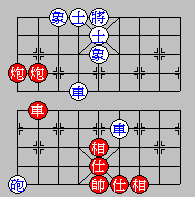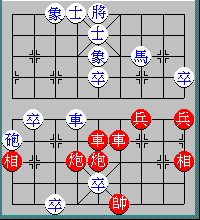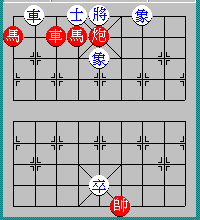36. If a move in a perpetual chase is an offer to exchange, it
still constitutes a perpetual chase. If every move in a perpetual
chase is also an offer to exchange, it still constitutes a perpetual
chase. (See examples in Diagrams 90 to 93)
 Diagram 90: Red (in Capital) moves first
Diagram 90: Red (in Capital) moves first
R29 c12
R98 c21
R89 c12
R98 c21
R89 ....
Explanation:
Red offers to exchange the Cannons in every other move while
its Rook is perpetually chasing the Black Cannon. This is perpetual
chase and is violating the rule.
 Diagram 91: Red (in Capital) moves first
Diagram 91: Red (in Capital) moves first
R89 c12
R98 c21
R89 c12
R98 c21
R89 ....
Explanation:
In every move, Red chases the Black Cannon and offers to exchange
simultaneously. This is still a perpetual chase and is against the
rule.
 Diagram 92: Red (in Capital) moves first
Diagram 92: Red (in Capital) moves first
R56 r45
R65 r56
R56 r45
R65 r54
R56 ....
Explanation:
While offering to exchange the Rooks in each move, Red's Cannons
are perpetually chasing the Black Rook. This is against
the rule and Red has to change or lose.
 Diagram 93: Red (in Capital) moves first
Diagram 93: Red (in Capital) moves first
R78 r23
R87 r32
R78 r23
R87 r32
R78 ....
Explanation:
While offering to exchange the Rooks in each move, Red's Knights
are perpetually chasing the Black Rook. This is against the
rule and Red has to change or lose.




